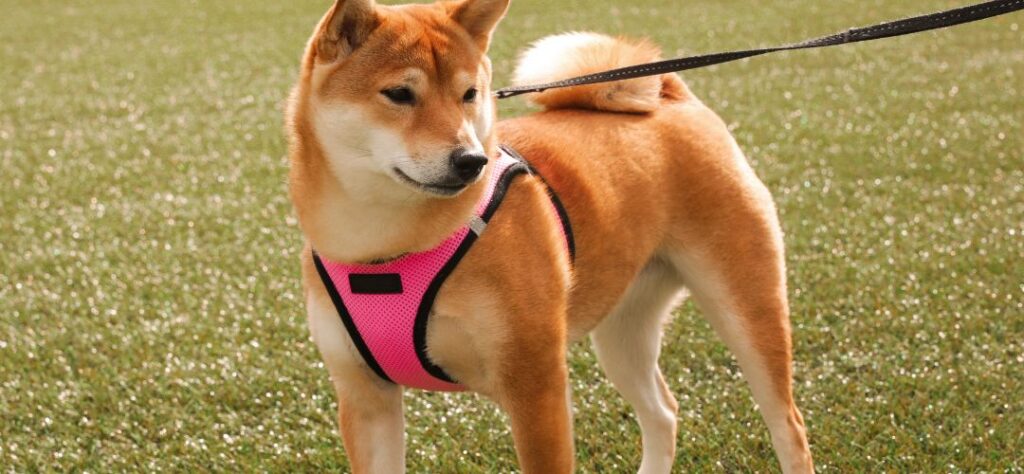If you’ve ever encountered a Shiba Inu, the answer to this question is likely a resounding “no!” With their mischievous tendencies and independent streak, Shibas are not your typical domesticated dog. They may look cute and cuddly, but they have a wild side that can make them difficult to control. So, if you’re thinking of taking your Shiba off leash, read on for some advice about how to do so safely! Who knows? Maybe with the right training and precautions, you’ll be able to trust your beloved pup off-leash one day. Let’s find out!
At the end of the day, it all comes down to trust. If you’ve taken the time to properly train your Shiba and have built a strong bond with them, then yes – you can trust a Shiba off leash. However, if your pup is still young or has not been trained properly, it’s best to keep them on their leash for safety’s sake. With patience and consistency, you’ll be able to trust your furry friend more and more over time.
How do I stop my Shiba Inu from running away?
One of the most challenging aspects of owning a Shiba Inu is their strong independent streak. While they may look cute and cuddly, Shibas have a wild side that can make them difficult to control. If your pup has taken off when you least expect it, it’s important to nip this behavior in the bud before it becomes a habit.
The key is to ensure that your Shiba knows who’s in charge – you! Start by establishing yourself as the leader with gentle yet firm commands and consistent reinforcement of desired behaviors. Make sure your pup understands basic obedience commands such as sit, stay and come so you can maintain control on walks or during playtime outside. You should also use positive reinforcement to reward your pup for obeying commands.
You can also help prevent your Shiba from running away by providing them with safe, fenced-in areas where they can play and explore without fear of danger or getting lost. Make sure the fences are tall enough that your pup won’t be able to jump over them or dig underneath them. Consider investing in a collar with a GPS tracker so you can keep an eye on your pup’s location at all times, even when they’re off leash. Additionally, make sure any gates are locked securely and that the locks cannot be tampered with easily by curious Shibas!
Finally, always remain alert whenever you take your Shiba out for a walk. Be aware of potential distractions that may cause your pup to lose focus and wander off. If you are ever concerned about your pup taking off, it’s best to err on the side of caution and keep them securely on a leash until you can be sure they are reliable.
With patience and consistency, you can teach your Shiba Inu to come when called and remain close by so that you can trust them off-leash over time. Remember, never let their size fool you – with proper training, Shibas are loyal and devoted pets who will show just how much they love their human companions! With the right nurturing environment, you’ll be able to trust your furry friend more and more each day.

Are dogs happier off leash?
Most dog owners would agree that their pup is happiest when they’re running free, exploring the world around them and taking in all its sights and smells. But when it comes to whether or not dogs are actually happier off leash, the answer isn’t so simple. In some cases, a dog may be better off with some freedom to roam; however, there are also many circumstances where a leash can provide structure and security for your pup.
When considering if your dog should be allowed to go off-leash, you need to factor in their personality, obedience level and any potential risks associated with being unleashed. For example, if your pup is friendly but easily distracted by other animals or people they encounter on walks, it might be best to keep them on a leash. This will help you keep control of your pup and prevent any unfortunate accidents or confrontations with other animals.
On the other hand, if your dog is well-behaved and obedient, allowing them off-leash can give them a sense of freedom they may not get while leashed. Dogs love to roam and explore their environment – smelling new scents, chasing birds or squirrels, playing fetch with you or simply running around for fun. Allowing them room to move without feeling restrained by a leash can make for an enjoyable experience and provide mental stimulation for your pup.
Ultimately, whether dogs are happier off-leash depends largely on the individual pup’s personality and their ability to be attentive to their owners’ commands. A well-mannered dog who can respond quickly and efficiently to verbal cues or hand signals is much more likely to benefit from being unleashed than an unruly pup who may get too distracted or wander off. That said, some dogs are simply better suited for walks on a leash and still enjoy them just the same!
Whatever your decision may be, it’s important to factor in both safety and comfort for your pup when considering whether you should let your canine companion go off-leash. Knowing that your dog has the freedom to explore while still feeling secure can provide peace of mind for both you and your furry friend. So go ahead, take off the leash – but always keep an eye on your pup!
What breed of dog is least likely to run away?
A truly reliable and trustworthy pet is not defined by a specific breed of dog, as all breeds can be trained to dependably obey their owners. Some breeds may have a tendency to run away more often than others, due to their size or personality traits, but with proper training and socialization, any pup can learn to stay close by its owner’s side.
Smaller dogs tend to be less likely to wander off than larger ones. Since they don’t have the same range of motion as larger breeds, they are more content staying close because it requires less effort for them, while still allowing them to explore their surroundings. This makes toy breeds such as Chihuahuas, Yorkshire Terriers and Pomeranians some of the least likely dogs to run away.
Breeds known for their intelligence, such as Australian Shepherds and Labrador Retrievers, are also less likely to wander off, as they can easily be trained to stay close by their owners or obey commands. These breeds tend to pay more attention to their owners than other breeds may, making it much easier to keep them in check with verbal cues or hand signals.
On the opposite end of the spectrum are breeds with a strong “prey drive” – that is, an instinctive urge to chase after small animals like squirrels and birds. These include Greyhounds, Jack Russell Terriers and Whippets – all breeds which have been bred for centuries to be hunting dogs. A dog with a strong prey drive, even when trained, may be more prone to running away and following their noses than other breeds.
Finally, Shiba Inus are known for being independent thinkers and having very strong personalities, so they may not always obey commands or stay near their owners like other breeds. While Shibas can still make great family pets, off-leash training is not recommended as the risk of them running away is much higher than with most other breeds.
What to do if an off leash dog approaches your dog?
The most important thing to do if an off-leash dog approaches your own pooch is to remain calm and not panic. Yelling at the other animal or trying to physically intervene may only make matters worse, as it could lead them to become more aggressive with your pup. Instead, try using body language and vocal commands in order to keep both dogs relaxed.
If you’re able, attempt to move yourself and your pet away from the situation in a slow and non-threatening manner. This will help avoid any potential conflict between the two animals, as they are less likely to feel threatened by a person who appears unconcerned about their presence. You can also use treats or toys as distractions for either dog so that they will focus on something other than each other.
In order to protect your pup from off-leash animals that may be aggressive, it is also important to keep them on a leash at all times when in public areas. This ensures that you can maintain control over the situation if an off-leash animal approaches and can prevent a potentially dangerous encounter between the two dogs.
Finally, it’s important to ensure that all of your pet’s vaccinations are up to date and that they have been spayed or neutered before bringing them out in public. Not only will this help reduce the risk of any health issues being spread between animals, but it also makes sure that they won’t be attracted to any other dogs that may also be running off-leash.

Is it rude to not have your dog on a leash?
That’s a matter of opinion, but it is important to remember that safety should always come first. While Shiba Inus are known for being loyal and trustworthy, you can never be too careful when it comes to their interactions with other animals. By following the tips above, you can help keep everyone safe and enjoy your time outdoors with your beloved pooch!
When it comes to whether or not it is rude to have your dog off-leash, consider the context in which you are doing so. For instance, if you’re on a walk in a park that does not allow unleashed dogs, then it would be viewed as disrespectful and irresponsible to ignore that rule. On the other hand, if you are in an area where off-leash walks are allowed, then having your dog run free may be perfectly acceptable.
No matter the situation, remember that having your pet off leash can be potentially dangerous for both them and other animals they may come into contact with. While Shiba Inus may have a reputation for being obedient and well behaved when on their own, there is a risk of them running off and getting into trouble. In addition, if they do happen to approach another dog while off-leash, the situation could quickly become dangerous if either animal feels threatened or provoked.
It isn’t just other animals you have to look out for though. You should also be aware of any potential hazards that may arise during your time outdoors with your pup – from unexpected traffic to wild animals – so that both you and your furry friend remain safe at all times.
Ultimately, it is up to you as a pet owner to decide how much freedom you allow your Shiba Inu when out in public. However, never forget that safety comes first – whether on leash or off!
How do I train my Shiba Inu not to pull on the leash?
Training your Shiba Inu not to pull on the leash does not happen overnight and requires patience, consistency and positive reinforcement. Here are a few tips that may help you get started:
1. Start with short walks – Begin your training by taking short strolls around the block or in your garden. This will give both of you time to adjust and will allow you to take frequent breaks when needed.
2. Use treats as rewards – Whenever your pup is walking calmly beside you, reward them with a treat or a toy to motivate them further. It’s important to remember that these should only be given when they are behaving properly, otherwise their behaviour could become reinforced in the wrong way!
3. Make turns – Whenever your Shiba Inu starts to pull, stop in your tracks and make a 180 degree turn. This will signal to them that pulling on the leash is not something you want them to do and will help break the habit over time.
4. Distract with toys – If you notice that your pup begins to get bored, use a toy or treat to distract them from pulling. The key is to ensure they stay focused on the distraction until they forget what it was they wanted so badly at first!
5. Stay consistent – As mentioned before, training takes time and consistency is key here. Stick with the same commands each time, don’t give in too easily if your pup stops responding and be sure to praise them when they do as you ask.
These are just a few tips that can help you and your Shiba Inu learn how to walk calmly on the leash without pulling. It is important not to give up too easily, stay consistent in your training methods and be patient with yourself and your pup – if you put in the effort it will pay off! With enough practice, soon enough you and your furry friend will be enjoying walks like old times. Good luck!
Can some dogs never be off leash?
The answer to this question varies depending on the individual dog and their level of training. Generally speaking, not all dogs can be safely off leash as it is a difficult behavior for them to master and often requires extensive training. It is important to understand that some breeds are more easily trained than others, so if you have a breed known for its intelligence such as a Border Collie or German Shepherd, they may have an easier time learning how to walk off leash.
For those dogs who cannot be trusted off leash, there are certain steps owners should take in order to keep their dog safe and secure. The first step is making sure that any area your pup will be going into has proper fencing and/or containment systems in place. This is especially important if you live in an area with a lot of traffic or wildlife that could cause harm to your pet. Additionally, be sure to never leave your pup unattended as even the most obedient dog can become distracted and wander off.
Finally, it is important to remember that not all dogs are capable of being trained off leash; some may require a great deal of time, patience, and consistency for them to learn this behavior safely. In these cases, owners should consider investing in a long line or similar training device so their pup can still enjoy exploring outdoors without having to worry about them getting lost or running into danger when they are off leash.
Conclusion | Can you trust a Shiba off leash?
This article discusses whether or not all dogs can be trusted off leash, noting that some breeds are easier to train than others. It also outlines the steps owners should take in order to keep their pup safe and secure if they cannot be trained off leash, such as proper fencing/containment systems and never leaving them unattended.


